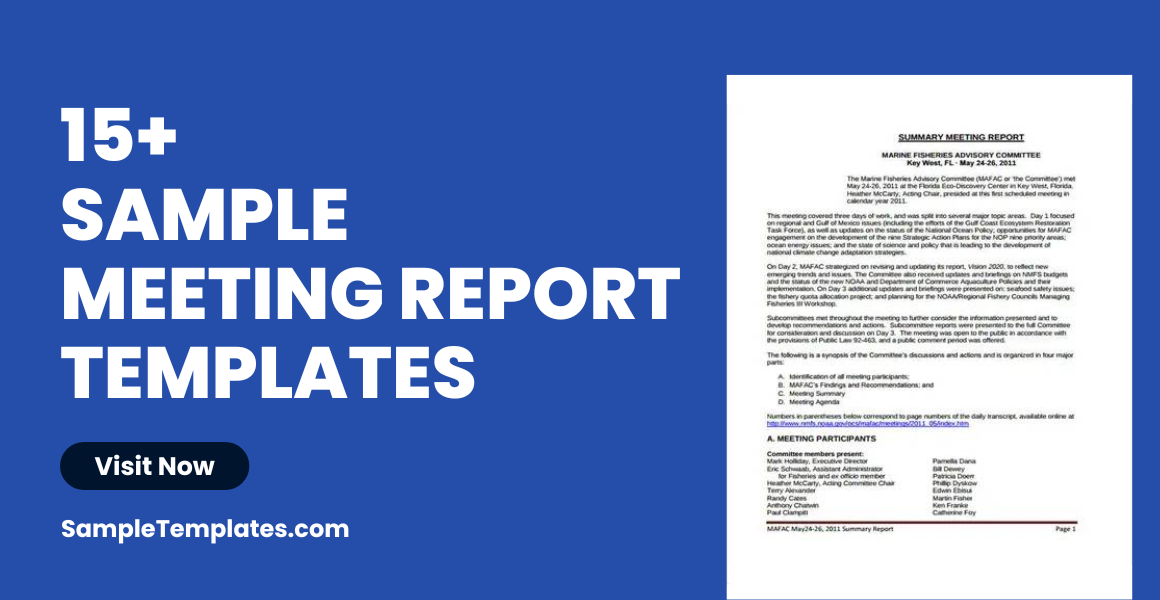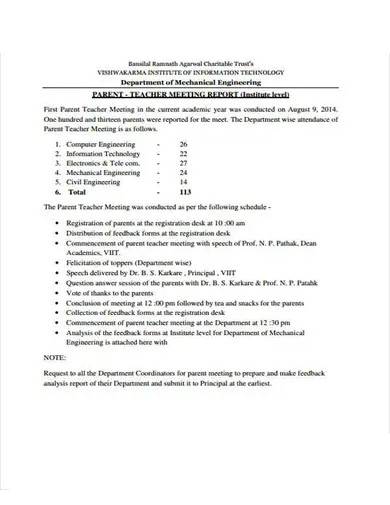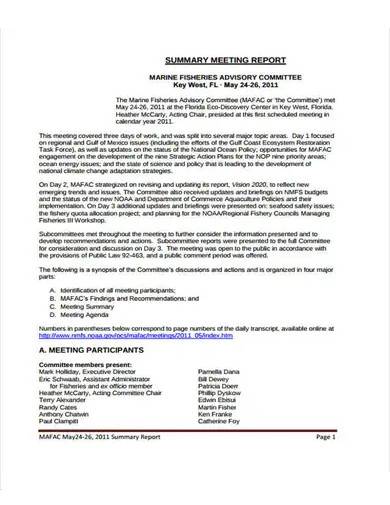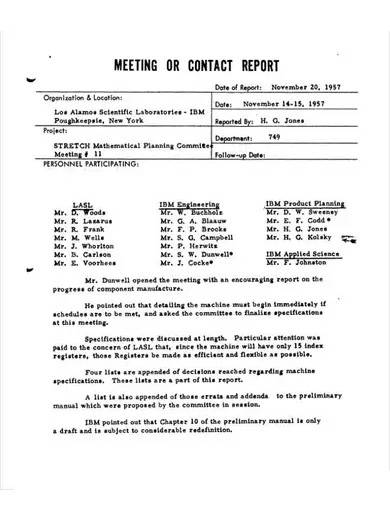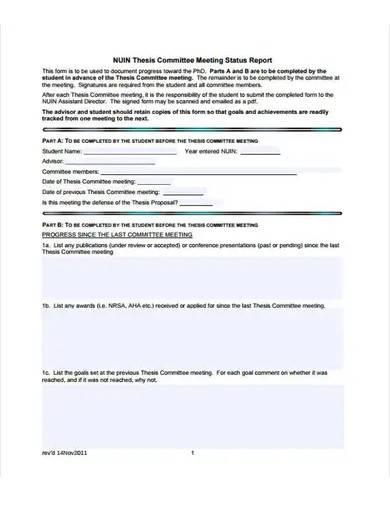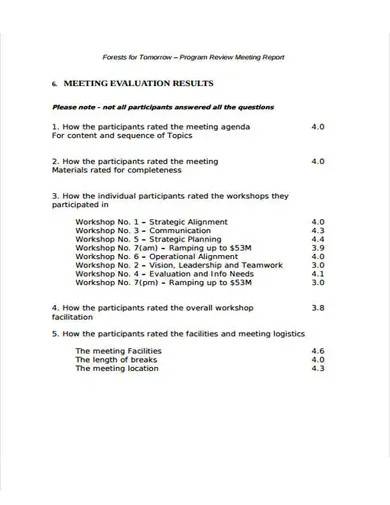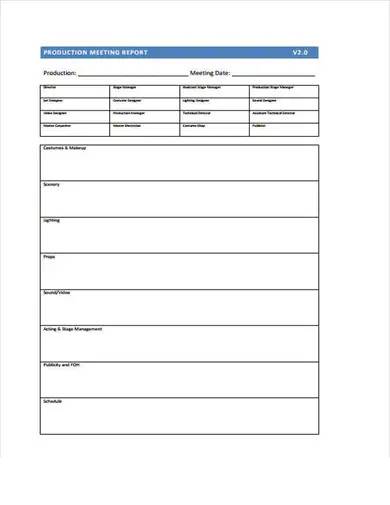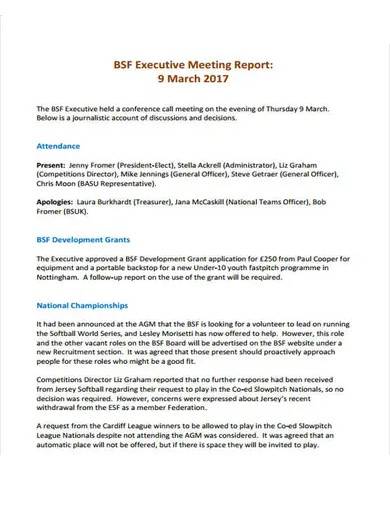Business meetings, department huddles, and group sessions are necessary for keeping a working space’s camaraderie and engagement alive. They encourage every role to take their noses away from their tasks and exchange ideas with other people towards the accomplishment of their goal plans. A meeting report sample is a valuable tool in ensuring that the matters discussed during these sessions are documented for distribution and as an important resource in the future.
FREE 15+ Meeting Report Samples
1. Meeting Agenda Report Template
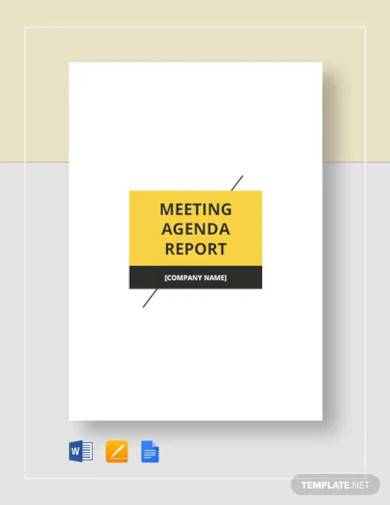
2. Meeting Outcome Report Template
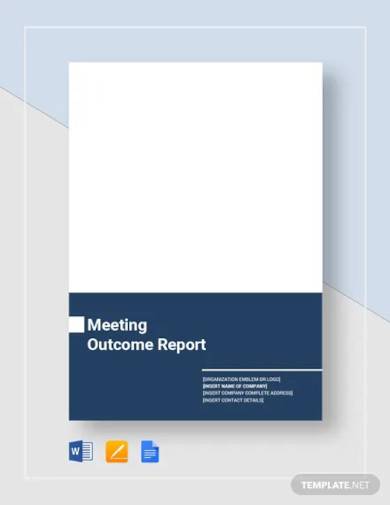
3. Meeting Summary Report Template
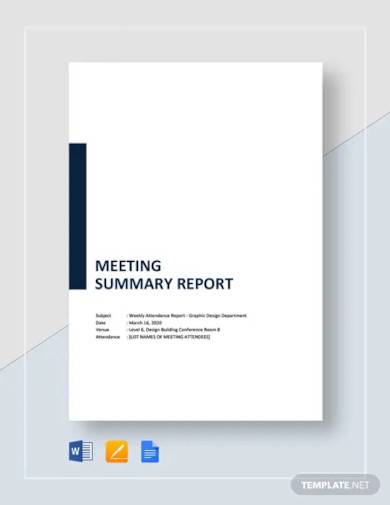
4. Daily Meeting Report Template
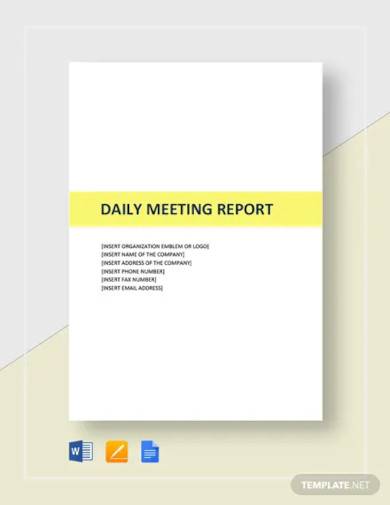
5. Business Meeting Report Template
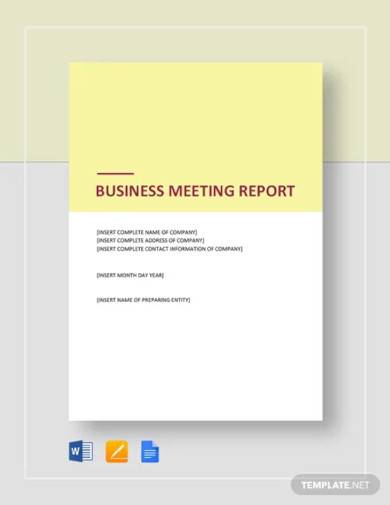
6. Board Meeting Report Template

7. Free Meeting Minutes Report Template
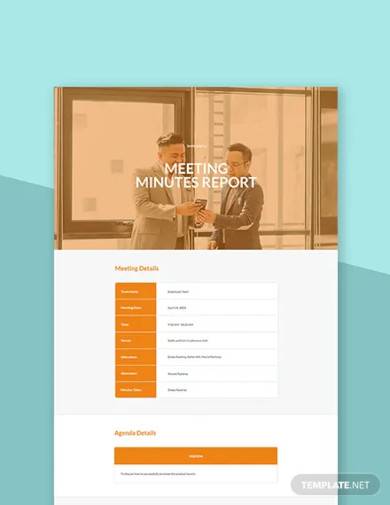
8. Free Board Meeting Report Template
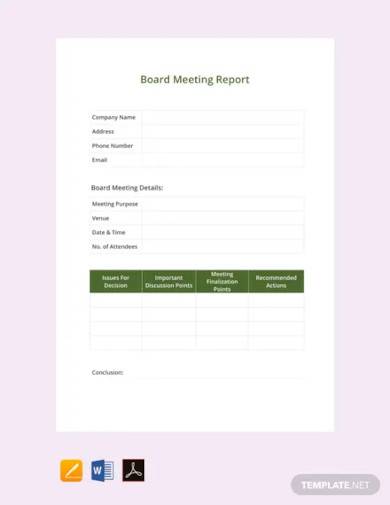
9. Parent-Teacher Meeting Report
10. Meeting Summary Report
11. Meeting or Contact Report
12. Commitee Meeting Status Report
13. Program Review Meeting Report
14. Committee Meeting Report Sample
15. Production Meeting Report
16. Executive Meeting Report Sample
What Is a Meeting Report?
A meeting report provides a comprehensive summary of what transpired during a meeting or discussion. It captures the gist of the presentation and the agendas presented and supply a summative account of all the important highlights, decisions, tasks, and other concerns. It will serve as the process documentation of the meeting, which can benefit those who weren’t able to attend the discussion. It can also serve as a valuable resource that the organization can revisit later on.
Elements of Productive Meetings
While it has noble intentions, 67% of workers deem meetings as a distraction. They say excessive meetings are hindering their performance. Only 11% of them think that the meetings are productive while the rest have negative sentiments about it. It puts sessions and gatherings at a bad light and may contribute to people saying they don’t see the point of having meetings as they already have pre-existing prejudice on the activity.
However, when meetings are done the right way, it can have several benefits. According to the HuffPost, among the advantages of holding effective meetings include increasing your strategy’s quality, increasing member engagement, and being constantly aware of the organization’s goals and how to achieve them.
To help lift the ugly perceptive stains on meetings, here are the elements of productive meeting sessions:
1. Clear and well-thought objectives. Productive meetings are rooted in a set of clear and planned objectives. The discussions need to start somewhere strong and relevant, and it has to end in something that the organization can benefit from. A clear objective breeds good agendas where they can establish the right action plan.
2. Interactive. A meeting with a roomful of a passive crowd where only there’s only a one-way communication coming out from the speaker is not a meeting anymore but a lecture. Meetings should encourage engagement and conversation. The committee should keep in mind in what way the audience can interact and input their suggestions.
3. Time conscious. Employees consider meetings as a distraction because it consumes too much of their time, keeping them away from their actual task. Keep the meeting brief by including only what’s necessary during the transaction. Also, an average adult only has an attention span of 10 to 20 minutes. You might think that a lengthy meeting helps you cover more topics, but you might be talking to an unresponsive audience whose thoughts are already far and away.
4. Actionable results. When people know what they’re supposed to after the meetings, then that’s a win for you. Be sure to prioritize task lists and assignments for a related project plan or any pending activity. It allows your participants to act, coordinate, and bring in results that will satisfy your goals.
How to Write a Meeting Report
If you’ve wanted to write a meeting report, here are some tips for you:
1. Take Note of the Agenda
When making a meeting report, the first you should include in your document is the meeting agenda. It will indicate your session’s goals and will give the rest of the participants an idea of what is all about. Your discussion will revolve around your established agenda, so it’s only right that your meeting report includes them. In most cases, a meeting announcement will tell what the agenda will be. However, if it’s an impromptu or an unscheduled meeting, you need to take note of what the agenda is actively.
2. Include Basic Meeting Details
Aside from the agenda, don’t forget to include your meeting’s basic details such as the meeting schedule, location, and the participants of the discussion. You should also mention who the meeting chair and who’s the assigned meeting committee to handle the program. It’s an important part of your report as this tells you what the meeting was like and who were the active roles present during the session.
3. Lookout for the Highlights
The meeting highlights are the most important details tackled during the session that should dominate your sample report. These are the main point, decisions, votation results, assigned tasks, and other pertinent details that are important to the discussion. Rather than making a transcript out of the presentation, strive to capture the significance of the details. This way, you won’t end up with an excessive amount of details and fail at extracting the executive summary of the discussion.
4. Evaluate Your Work
Now that you have everything you need, it’s time to check your output and see if you’ve included everything significant to making your report. If you’ve been taking the notes for the minutes of the meeting yourself, visit your copy and ensure that you’ve taken all the important ideas for your document.
FAQs
How do you differentiate a meeting report from meeting minutes?
Most people often confuse meeting report as meeting minutes. While the two have an identical function and can provide the same information, a meeting report is fairly brief and contains only the most important parts. On the other hand, the minute of a meeting is detailed and holds more specific elements.
How often should you hold meetings in a week?
Business meetings such as those involving team members, management officers, and others could happen once or twice per week, depending on their needs.
When is the best time and day to hold a meeting?
According to research by YouCanBookMe, Tuesday at around 2:30 P.M. is the best time and day for meetings.
The meeting reporting contains a comprehensive account of the discussion’s topics and important decisions. It summarizes what has been shared and presented and will serve as documented proof that certain matters were discussed and agreed during the session. Check out our collection of meeting report templates that you can use for your needs. Download now!
Related Posts
Sample Technical Reports
Sample Security Incident Reports
Trip Report Samples & Templates
Sample Book Report Templates
Sample Chemistry Lab Reports
School Accomplishment Report Samples & Templates
Field Report Samples & Templates
Sample Science Project Reports
Business Report Samples & Templates
Survey Reports Samples & Templates
Sample Feasibility Reports
Psychological Assessment Report Samples [ Clinical, Child, Intake ]
Report Format Samples & Templates
Acknowledgement for Internship Report Samples [ Hotel, Hospital, Teaching ]
Field Trip Report Samples [ Agriculture, Educational, Environmental ]
